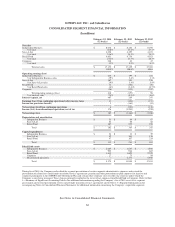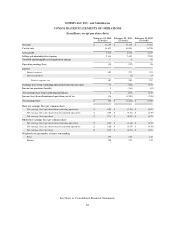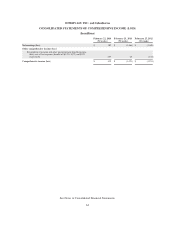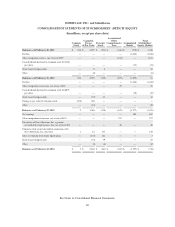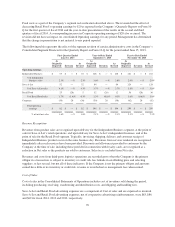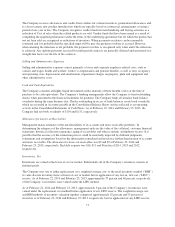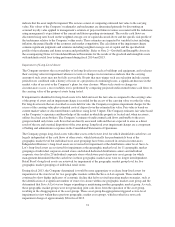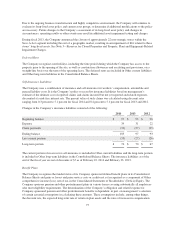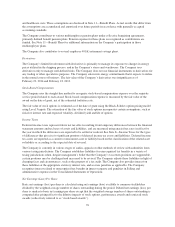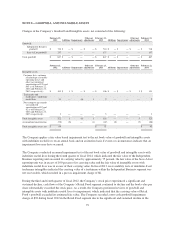Albertsons 2014 Annual Report Download - page 74
Download and view the complete annual report
Please find page 74 of the 2014 Albertsons annual report below. You can navigate through the pages in the report by either clicking on the pages listed below, or by using the keyword search tool below to find specific information within the annual report.Under the replacement cost method applied on a LIFO basis, the most recent purchase cost is used to calculate
the current cost of inventory before application of any LIFO reserve. The replacement cost approach results in
inventories being valued at the lower of cost or market because of the high inventory turnover and the resulting
low inventory days supply on hand combined with infrequent vendor price changes for these items of inventory.
The Company uses one of either cost, weighted average cost, RIM or replacement cost to value certain discrete
inventory items under the first-in, first-out method (“FIFO”). The replacement cost approach under the FIFO
method is predominantly utilized in determining the value of high turnover perishable items, including Produce,
Deli, Bakery, Meat and Floral.
As of February 22, 2014 and February 23, 2013, approximately 25 percent and 23 percent, respectively, of the
Company’s inventories were valued using the cost, weighted average cost and RIM methods under the FIFO
method of inventory accounting. The remaining 18 percent and 17 percent of the Company’s inventories as of
February 22, 2014 and February 23, 2013, respectively, were valued using the replacement cost approach under
the FIFO method of inventory accounting. The replacement cost approach applied under the FIFO method results
in inventories recorded at the lower of cost or market because of the very high inventory turnover and the
resulting low inventory days supply for these items of inventory.
During fiscal 2014, 2013 and 2012, inventory quantities in certain LIFO layers were reduced. These reductions
resulted in a liquidation of LIFO inventory quantities carried at lower costs prevailing in prior years as compared
with the cost of fiscal 2014, 2013 and 2012 purchases. As a result, Cost of sales decreased by $14, $6 and $9 in
fiscal 2014, 2013 and 2012, respectively. If the FIFO method had been used to determine cost of inventories for
which the LIFO method is used, the Company’s inventories would have been higher by approximately $202 and
$211 as of February 22, 2014 and February 23, 2013, respectively.
The Company evaluates inventory shortages throughout each fiscal year based on actual physical counts in its
facilities. Allowances for inventory shortages are recorded based on the results of these counts to provide for
estimated shortages as of the end of each fiscal year.
Reserves for Closed Properties
The Company maintains reserves for costs associated with closures of retail stores, distribution centers and other
properties that are no longer being utilized in current operations. The Company provides for closed property
lease liabilities based on the present value of the remaining noncancellable lease payments after the closing date,
reduced by estimated subtenant rentals that could be reasonably obtained for the property.
The closed property lease liabilities usually are paid over the remaining lease terms, which generally range from
one to 15 years. Adjustments to closed property reserves primarily relate to changes in subtenant income or
actual exit costs differing from original estimates. Adjustments are made for changes in estimates in the period in
which the changes become known.
Business Dispositions
The Company reviews the presentation of planned business dispositions in the Consolidated Financial Statements
based on the available information and events that have occurred.
The review consists of evaluating whether the business meets the definition as a component for which the
operations and cash flows are clearly distinguishable from the other components of the business, and if so,
whether it is anticipated that after the disposal the cash flows of the component would be eliminated from
continuing operations and whether the Company will have any significant continuing involvement with the
business. In addition, the Company evaluates whether the business has met the criteria to be classified as a
business held for sale. In order for a planned disposition to be classified as a business held for sale, the
established criteria must be met as of the reporting date, including an active program to market the business and
the expected disposition of the business within one year.
72


